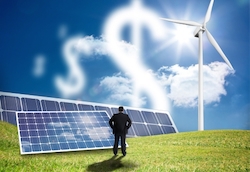The Clean Energy Group, the Brookings Institution and the Council of Development Finance Agencies have released a paper on a powerful but underutilized tool for future clean energy investment: state and local bond finance. The report, “Clean Energy Finance through the Bond Market: A New Option for Progress,” find that as Federal clean energy subsidies  decrease, agencies that issue public finance bonds are willing to finance renewable energy and efficiency projects. However, the report says, the clean energy community must embrace the bonds as a new finance tool.
decrease, agencies that issue public finance bonds are willing to finance renewable energy and efficiency projects. However, the report says, the clean energy community must embrace the bonds as a new finance tool.
According to the report development agencies are only experimenting with clean energy bonds. However, the bond finance community has accumulated significant experience in getting project finance to scale and knows how to raise large amounts of needed capital by selling bonds to Wall Street. The challenge, then, is to create new models for clean energy bond finance in states, and to establish a new clean energy asset class that can easily be traded in capital markets.
With this in mind, the report argues that state and local bonding authorities and others to do the following:
- Establish mutually useful partnerships between development finance experts and clean energy officials at the state and local government levels.
- Expand and scale up bond-financed clean energy projects using credit enhancement and other emerging tools to mitigate risk and through demonstration projects.
- Improve availability of data and develop standardized documentation so that the risks and rewards of clean energy investments can be better understood.
- Create a pipeline of rated and private placement deals, a new clean energy asset class, to meet the demand by institutional investors for fixed-income clean energy securities.
“Another report issued this week from the global scientific community at IPCC underscores the urgency of finding new ways to finance no-carbon technologies at massive scale,” said Lewis Milford, president of CEG and co-author of the report. “We need to finance clean energy the same way we have financed large public infrastructure projects and make sound investments that will benefit generations with low bond rates for new, clean energy generation. Our current way of financing clean energy not only makes it too expensive, but it simply cannot meet climate mitigation and adaptation demands in the next few decades.”

